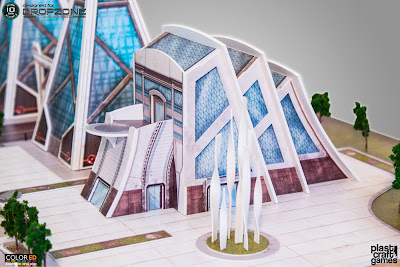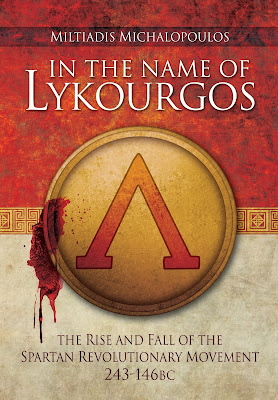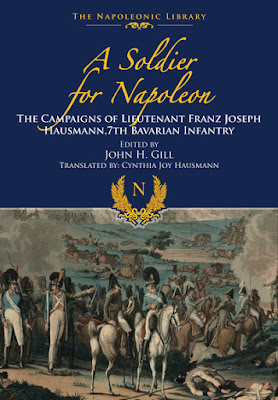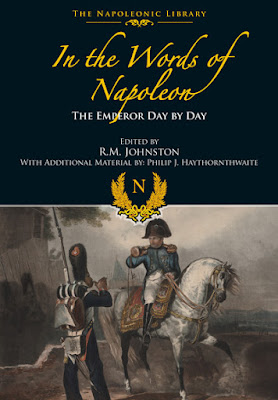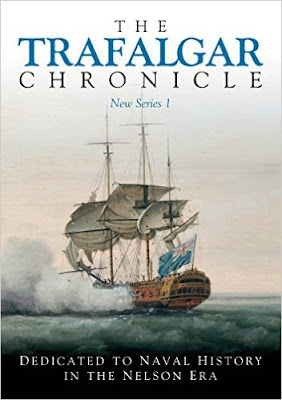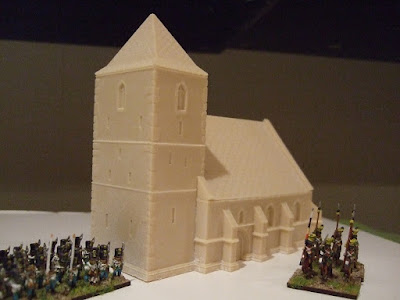Plast Craft Games has now expanded upon their ColorED terrain range, providing you with a collection of pre-coloured terrain pieces, to now include the 10mm battlefields of Dropzone Commander!
As you can see their new collection of buildings allows you to create a shining city, an example of humanity’s prosperousness as they head towards the stars. It also makes it the perfect target for a Scourge invasion.
There’s a wide variety of different building types for you to choose from here including some that are similar in shape and style to buildings we would see on the streets nowadays.
Then, you have those massive triangular structures with the bridge crossing over the road immediately stepping things up and taking us towards the futuristic.
As well as some neat examples of the buildings having those extra layers to them promoting different design choices, the additional levels add to the way you play the game as you’ll be positioning your troops up on those bridges and rooftops looking down at the battle going on below.
We do particularly like those triangular buildings although the one with the sloped sides you see in the image above here has a decidedly Cyberpunk feel to it. It looks like something you’d have seen in the world of Blade Runner.
This building here with the small helipad on the top floor means that you might be leading some extraction missions from there. The terrain, coming basically ready to play, means that you immediately start thinking of the gaming possibilities and we’re thinking up quite a few!
Now you just need to think about how you’d ‘ruin’ this terrain when the Scourge takes over. We think lots of overgrown vegetation would be a big help as it reclaims those shining glass buildings.
Plast Craft Games
30 Nov 2016
British Army Uniforms of the American Revolution 1751 - 1783
Based on contemporary records and paintings, this book identifies each cavalry and infantry regiment and illustrates changes in uniforms, their facing colours and the nature and shape of lace worn by officers, NCOs and private soldiers from 1751 to 1783. Regiments that served in the American War of Independence are noted and the book includes more than 200 full-colour plates of uniforms and distinctions. Divided into four sections, it not only details the cavalry and infantry uniforms of the period but also the tartans of the Highland regiments, some of which were short-lived, and the distinction of the Guards' regiments.
Julius Caesar's Disease
It is generally accepted as a historical fact that Julius Caesar suffered from epilepsy, an illness which in classical times was sometimes associated with divinely bestowed genius.
The ancient sources describe several episodes when, sometimes at critical junctures, one of the most famous military commanders in history was incapacitated by his illness referred to as morbus comitialis.
But does the evidence really fit with the diagnosis of epilepsy? And if it was not epilepsy that afflicted Caesar, then what was it? These are the questions that doctors Galassi and Ashrafian seek to answer by applying modern medical knowledge to the symptoms and circumstances described by contemporary historians and commentators of Caesar's life (which include the great man himself).
The result is a fascinating piece of historical-pathological detective work that challenges received wisdom about one of the most famous men of all time.
In the Name of Lykourgos: The Rise and Fall of the Spartan Revolutionary Movement (243-146BC)
In the middle of the 3rd century B.C. Sparta was a shadow of its glorious past. Politically and militarily weakened and with huge inner social problems, she seemed to have followed the fate of most contemporary city- states and fallen on the fringe of the political developments of her time.
The 3rd century was a time when the great states and the Hellenistic empires were prominent. But contrary to the other city states, which compromised with the new political forces of their time, Sparta resisted stubbornly and tried to reclaim the hegemony of southern Greece. In this fight, Sparta showed unexpected vigor, even defying one of the most formidable powers of the time: Macedonia. The uneven collision that followed culminated tragically and painfully for Sparta at the Battle of Sellasia in 222BC.
And still Sparta refused to compromise. After a while, she managed to recover and became once more a player on the international stage, not hesitating this time to challenge the most powerful state of the ancient world: Rome.This last Spartan twilight, the revolutionary movement that sparked it and the two ultimate turning points of her history the battle of Sellasia and the siege of Sparta by the Romans are analysed in this book with exhaustive bibliography and special emphasis on the military aspects of this epic fight.
The original Greek edition of In the Name of Lykourgos received great critical acclaim and was named winner of the 2009 Lakedaimonian Prize of the Academy of Athens. It is here translated into English for the first time.
The Arte Militaire: The Application of 17th Century Military Manuals to Conflict Archaeology, by Warwick Louth
Military Manuals have been used as a source through a range of historical studies, but only recently has their potential to conflict archaeology truly been recognised. Military manuals allowed the progression of the military revolution from the informed amateur, towards the scientific, mathematical choreography for choreography of massed troops at the height of the Military Revolution; their use as a viable historical resource often taken at face value, negating their worth. Using correlated GIS, landscape archaeology, metal detecting, military knowledge and experimental archaeology, we might understand more fully the limitations and strengths drill books provide us. Like a dance, military theory provides a certain number of ways individuals may progress through a landscape. Using examples taken from recent investigations at sites such as Edgehill, Lutzen and Lostwithiel, this paper shall examine to what extent individual drill can be identified in the archaeological record. This publication hopes to prove to what level and extent this can be applied to predictive modelling of artefact collections on battlefields, thus providing depth to the archaeological study of fields of conflict.
Like investigations on the Little Bighorn Battlefield, through use wear analysis of the material remains of conflict, can we effectively tell the nuances of individual drill, practice and movement of people across a landscape, their drill actively mirroring subtleties in our understanding of interpretation? Taking the works of such writers and artists, such as Bariffe, de Gheyn and Ward, the author attempts to actively breakdown how individual and group drill will leave material remains and the archaeological means these might be taken down. But equally, this work also attempts to investigate and breach the subject of whether such manuals can also be used to dictate the survivability of 17th century fortifications, often within urban landscapes devoid of their Civil War origins, as can be seen at Alton and Basing House. Theoretical in its nature and utilising and combining elements of research not previously collaborated, The Arte Militaire is unique in not merely showing how military manuals were used, but rather how they can still be utilised and seen within the historical landscape. Contains c 50 b/w ills, diagrams, maps.
Third Reich Victorious: Alternative Decisions of World War II
'Peter G. Tsouras does an excellent job ...Readers will marvel at just how close Germany came to winning a key event in World War II.'
Air & Space Power Journal 'Convincing.' Pennant: The Journal of the Forces Pension Society. 'Fascinating.' Magweb.
War is a deadly game of chance where a single detail or decision can have far-reaching consequences.
What if Hitler's generals had captured the cream of the British Expeditionary Force at Dunkirk? What if Turkey had sided with Germany and smashed through Russia's back door to claim the prized Caucasus oil fields? What if Rommel had driven the British back into the sea on D-Day and the Luftwaffe had defeated the RAF in the Battle of Britain.
The Allies could have lost the Second World War in many ways, and ten noted historians show clearly how in this collection of fascinating, provocative scenarios, based on meticulous research. By turns gripping and chilling, Third Reich Victorious offers a fresh insight into the vagaries of war that can make all the difference between the victor and the vanquished.
A Soldier for Napoleon: The Campaigns of Lieutenant Franz Joseph Hausmann - 7th Bavarian Infantry (Napoleonic Library)
Fills a very noticeable gap in the history of the Napoleonic Wars by providing a good description of what it was like to be a member of the Royal Bavarian Army.' HistoryNet.
The letters and diaries of Lieutenant Franz Joseph Hausmann are here placed in the context of the military events of the period by renowned historian John Gill.
They stem from Hausmann's first campaign in 1805 in the war against Austria, followed by the 1806 and 1807 campaigns in Prussia and Poland.
In 1809 he was in action against the Tyrolean insurrection and he also fought at Abensberg and Zniam. He was only twenty-three when he embarked on the ill-fated 1812 invasion of Russia and served as part of the Bavarian corps that was shattered in this cataclysmic campaign. He survived to describe the 1813 campaign and the 1814 campaign in France when the Bavarians switched sides and fought against Napoleon.
With additional commentary by John Gill on the Bavarian Army and its campaigns and battles, this book is an important, authoritative addition to the works on the Napoleonic Wars.
In the Words of Napoleon: The Emperor Day by Day (Napoleonic Library)
' ...a powerful portrait of a complex individual. It uses Napoleon's own words to show his genius, arrogance, insecurities, and frustrations.
The reader will be amazed by Napoleon's attention to detail, from those of pressing national interests to the mundane (such as the problem of heartbroken soldiers in his guard.) ...
This makes it an invaluable reference book that should be on the bookshelf of anyone interested in the period.' Rob Burnham, Editor, Napoleon Series.
In the words of Napoleon is a startling insight into the life and deeds of Napoleon I. Derived from Napoleon's extensive correspondence and his other writings and recorded speech, this valuable compilation acts as a diary or journal, encompassing the whole of the emperor's life.
Napoleon's words - as recorded on a particular day - are set down as 'entries', and these offer a unique glimpse into the major events of the Napoleonic period. The diary reveals Napoleon's thoughts and actions as his great life unfolded and throws light on his attitudes to war, politics and the many varied personalities who surrounded - or opposed - him.
As entries appear on an almost daily basis, the reader has the opportunity to trace the surging course of events as they happened, and to witness the emperor's response to the rise and fall of his fortunes. Philip Haythornthwaite provides a fascinating introduction which analyses Napoleon's words, and includes biographical sketches of the key personalities of the era.
The Trafalgar Chronicle: Number 26: Dedicated to Naval History in the Nelson Era: 1
The Trafalgar Chronicle, the yearbook of The 1805 Club, has established itself as a prime source of information and the publication of choice for new research about the Georgian navy, sometimes also loosely called Nelson s Navy.
Successive editors have widened the scope to include all sailing navies of the period, while a recurring theme is the Trafalgar campaign and the epic battle of 21 October 1805 involving British, French and Spanish ships, and some 30,000 men of a score of nations.
Contributors to the Trafalgar Chronicle are the leading experts in their field, whether they are Professor John Hattendorf from the US Naval War College in Newport, RI, Professor Andrew Lambert from King s College, London, or antiquarians and enthusiasts.
Each volume is themed and this new edition contains a particularly Anglo-American flavour, focussing on North America and North Americans in Nelson s Navy, with one article, for example, describing how the US National anthem was composed onboard a British warship.
More than eighteen articles offer a huge wealth of information and new research and include such diverse subjects as the true colours of Victory and the story of the little known American, Sir Isaac Coffin, who helped carry the pall at Nelson s funeral. Handsomely illustrated throughout, this yearbook casts intriguing light on that era of history which forever fascinates naval enthusiasts and historians alike.
Secret Duties of a Signals Interceptor: Working with Bletchley Park, the SDs and the OSS
The Second World War upended many lives, disrupting patterns and routines and bringing an array of terrifying new dangers with it.
For Jenny Nater, the war brought great sadness but also opportunity. Like many women left behind on the home front during the war, she found herself in an unforeseen scenario in which her talents could be put to an unexpected use.
But her war was destined to play out almost entirely in secret.Jenny served as a bilingual wireless operator in the top-secret Special Duties service (Y) at Dover, intercepting traffic from German surface craft in the English Channel and reporting it back to Bletchley Park (X). In this post she carried out important work for the war effort and also struck up a series of life-changing relationships, most notably with a Coastal Force Command Lieutenant, who was subsequently lost off the coast of Dover in tragic circumstances.
The story of how their careers interrelated, both on land and at sea, makes for thrilling and poignant reading. The memoirs also cover her time spent working for the American intelligence agency, the Office of Strategic Services (OSS), in Germany. It was whilst serving in this post that she would meet her husband, an OSS Officer and member of the Caterpillar Club.
His account of Mosquito missions over occupied Europe, tracing, identifying and communicating with special agents on the ground, is included here in full. These memoirs not only add an important layer to our understanding of allied intelligence practices conducted during this conflict, they also tell the story of one woman's very private war and the opportunities, sacrifices and victories it encompassed.
29 Nov 2016
Wargames Illustrated 350, December 2016
The December 2016 issue of Wargames Illustrated is available now.
Our theme for this month's magazine is Not your average Colonial Conflict – Gaming Colonial Wars throughout history, and we begin our colonial coverage in Roman Britain, before taking in the 1670 Battle of Tangiers, The Pig War gone hot of 1859, The Anglo-Pedi War, and The Druze Revolt.
We examine the new Team Yankee East German Intelligence Handbook Volks Armee, take a gloriously tongue-in-cheek look at the Barbarian Gentleman, present a How To… for making African Huts, a Rules Showcase of Dinoproof and plenty more besides, including in our Interactive magazine, a mini movie of some of the highlights of the recent Warfare show.
OBSERVATION POST
OP is a new regular monthly feature in which Henry Hyde (with a little help from his friends) takes a look at what’s new and impending in the wargaming world.
THEME: ROMAN CONQUEST OF BRITANNIA
We begin our theme content with a classic(al) example of the art of colonialism, the Romanisation of a mysterious land full of tribal politics and pagan worship.
HORSE AND MUSKET BLITZKRIEG – PART TWO
Barry Hilton presents more on the Great Northern War, taking a closer look at the nations involved.
THEME: THE OLD TANGIERS 1670 28
King Charles II’s North African colony and the efforts taken to defend it from those who sought to oust the British presence, as presented by Pete Brown.
TWO SIDES OF THE IRON CURTAIN
The Battlefront studio present facts and ‘figures’ from their forthcoming Team Yankee German Intelligence Handbook: Volks Armee.
THEME: THE PIG WAR GOES HOT
A war that could have been, with information and ideas for gaming the same by Dan Mersey for his The Men Who Would Be Kings rules.
CLUB FOCUS: MAIDSTONE WC
A snapshot of the gaming life of the Maidstone Wargames Society, as taken by John Lambshead.
THEME: WARGAMING THE ANGLO-PEDI WARS
Robert Giglio offers a decidedly different take on colonial-era Africa, with both the Boers and the British Empire taking turns to attempt to subjugate a tribal power.
RULES SHOWCASE: DINOPROOF
A small press set of wargames rules about larger than life heroes taking on dinosaurs great and small.
THEME: THE BATTLE OF MESSIFRE 1925
Another different take on colonialism, this time recounting the tale of the French Foreign Legion versus the Druze Revolt during the interwar years.
HOW TO: BUILD AFRICAN HUTS
Paul Davies shows us how to create typical African huts for use in a variety of colonial and native settings.
PROJECT SHOWCASE: DEMOING TEAM YANKEE
A look at the ideas and modelling options behind this game created by Phil Lewis which has been seen at a number of shows since its debut at Salute this year.
‘BUT ISN’T IT ALL JUST SCI-FI?’
Kenneth James provides a personalized look at why Konflikt ’47 has been added to his gaming repertoire.
THE BARBARIAN GENTLEMAN
A gloriously tongue-in-cheek examination of the reality of ‘barbarian’ life and attire during the time of the Romans.
HENRY HYDE’S BATTLEGAME
Our new columnist and ex-Miniature Wargames editor Henry Hyde shares some of his thoughts on the social and sociable side of our hobby.
THE 28TH MAORI BATTALION GREECE AND CRETE 1941
Arima Harwood looks at re-creating these redoubtable warriors of Aotearoa in two different scales and for his favourite two WW2 game systems.
Wargames Illustrated
Progress Report from Black Gate Miniatures
So four weeks after the Kickstarter funded and what is happening behind the scenes at Black Gate Miniatures?
Firstly, I have commissioned Robi Baker to sculpt the remaining 19 miniatures which will complete the Warriors, Armoured Warriors and Cannoneers. Orders have been placed for the dice and bases. When the stuff starts to arrive I will post up pictures of them.
I have also taken advantage of this lull in activity to start planning the Phase 2 Kickstarter. Due for early 2017, it will bring to life the Ogre Mammoth Riders and hopefully some characters too. The funding goal will be modest (£500) and Christian Schwager is drawing up some Shaman concept art for the Character Pack Stretch Goal.
Thanks again to everyone who backed the project.
Ogres forever!
Barry
Kickstarter
Black Gate Miniatures
Firstly, I have commissioned Robi Baker to sculpt the remaining 19 miniatures which will complete the Warriors, Armoured Warriors and Cannoneers. Orders have been placed for the dice and bases. When the stuff starts to arrive I will post up pictures of them.
I have also taken advantage of this lull in activity to start planning the Phase 2 Kickstarter. Due for early 2017, it will bring to life the Ogre Mammoth Riders and hopefully some characters too. The funding goal will be modest (£500) and Christian Schwager is drawing up some Shaman concept art for the Character Pack Stretch Goal.
Thanks again to everyone who backed the project.
Ogres forever!
Barry
Kickstarter
Black Gate Miniatures
28 Nov 2016
Large Church by Lancer Miniatures
Just added a large 10mm church which would be ideal for Napoleonics, and of course many other periods.
Andy has done a fantastic job in designing this impressive church, I am casting it in polymer resin, so very high detail and very strong. Will make any gaming table look good.
Lancer Miniatures
Andy has done a fantastic job in designing this impressive church, I am casting it in polymer resin, so very high detail and very strong. Will make any gaming table look good.
Lancer Miniatures
Banzai Age of the Country at War (2ndEd)
Banzai!, The age of the country at war (2nd Edition)
An elegant system focused on the feudal Japanese era (Sengoku Jidai) for the 6mm to 10mm size of wargaming.
This rules system is a tour de force and utilises unique features only found in 2D6 products!
Like a "wind up and go" command system which brings feudal command and control to re-alistic expectations, stunning artwork layout and more!
Features:
Incredible period style artwork
Authentic period tactics explained
Realistic command and control
Fast and detailed system
8 unique clans, 1 rebellious religious movement or make your own clan
Supports 3, 6 and 10mm size miniatures
Charge your samurai head long into your opponent's formation and carve your path to Kyoto to proclaim yourself shogun!
Watermarked PDF: $11.40 USD (40% off)
Softcover Color Book (Premium Heavyweight): $20.09 USD
Hardcover Color Book (Premium Heavyweight): $24.99 USD
Watermarked PDF + Softcover Color Book (Premium Heavyweight): $13.49 USD
Watermarked PDF + Hardcover Color Book (Premium Heavyweight): $18.39 USD
Wargame Vault
Napoleon, France and Waterloo: The Eagle Rejected
So great is the weight of reading on the subject of the Waterloo campaign that it might be thought there is nothing left to say about it, and from the military viewpoint, this is very much the case.
But one critical aspect of the story has gone all but untold - the French home front. Little has been written about the topic in English, and few works on Napoleon or Revolutionary and Napoleonic France pay it much attention.
It is this conspicuous gap in the literature that Charles Esdaile explores in this erudite and absorbing study. Drawing on the vivid, revealing material that is available in the French archives, in the writings of soldiers who fought in France in 1814 and 1815 and in the memoirs of civilians who witnessed the fall of Napoleon or the Hundred Days, he gives us a fascinating new insight into the military and domestic context of the Waterloo campaign, the Napoleonic legend and the wider situation across Europe.
27 Nov 2016
Stalin’s Favorite. Volume 2: From Lublin to Berlin, July 1944-May 1945: The Combat History of the 2nd Guards Tank Army from Kursk to Berlin
The author Igor Nebolsin continues with his detailed chronology of the 2nd Guards Tank Armys combat operations. This volume includes the hard fighting outside of Warsaw in the summer of 1944; the 1st Belorussian Fronts winter offensive in the Vistula Oder operation and the ensuing combat in Pomerania; and the final assault on Berlin, when the 2nd Guards Tank Army enveloped the German capital from the north and entered the city from north and west, fighting its way to the Tiergarten Park in the heart of Berlin. The author also briefly discusses the 2nd Guards Tank Army's subsequent history as part of the Group of Soviet Forces in Germany, its eventual disbanding in 1997, and its reconstitution four years later on 4 September 2001.
As with the first volume, the author s study is based upon the Army's operational documents from the Central Archives of the Russian Defense Ministry and recollections of its veterans, and received the active cooperation of Major-General Anatoly Shvebig, who was formerly a deputy commander of the 2nd Guards Tank Army s 12th Guards Tank Corps. It includes objective after-action reports from the Army's commander General Bogdanov and its subordinate formation commanders. Of note in this volume are General Bogdanovs recommendations for a tank army's table of organization and equipment and its proper use in combat operations, written shortly after the war ended. Illustrated with numerous images and supplemented with detailed tables, this volume completes the exhaustive study of the 2nd Guards Tank Army, Stalin's favourite
Stalin’s Favorite. Volume 1: January 1943-June 1944: The Combat History of the 2nd Guards Tank Army from Kursk to Berlin
26 Nov 2016
The Armored Fist: Combined Arms Combat in the Second World War
Armored Fist: a rule system for squad and individual vehicle all-arms combat during World War Two.
Suitable for company to battalion-sized actions during the Second World War, this system can simulate both infantry and combined arms operations and give realistic outcomes to combats early and late in the conflict. Simulate the real tactical choices that confronted commanders in every period of the conflict.
Core concepts are the alternating player turn, detection, defensive fire during the active player’s movement, and unit cohesion. This game is related to Modern Armor, a simulation of post-World War Two combined arms combat. The figure scale is a single vehicle or squad of infantry, with a turn covering (very) roughly five minutes of combat. The rules are written to allow hex or map measurement, with one unit of distance equaling 50 meters. Typical scale is 1”=50m as a decent compromise between the scale of micro-armor figures and playing spaces.
Included in this title:
Complete Rule System, including vehicle and equipment charts
Combat Tables
Game Counters and Artillery Templates
Quick Play and Historical Scenarios covering 1939 to 1945
Wargame Vault
November 2016, New Releases from Osprey Publishing Ltd
November 2016, New Releases from Osprey Publishing Ltd
Instrument of War
Drawing on more than a half-century of research and teaching, Dennis Showalter presents a fresh perspective on the German Army during World War I. Showalter surveys an army at the heart of a national identity, driven by - yet also defeated by - warfare in the modern age, which struggled to capitalize on its victories and ultimately forgot the lessons of its defeat.
Exploring the internal dynamics of the German Army and detailing how the soldiers coped with the many new forms of warfare, Showalter shows how the army's institutions responded to and how Germany itself was changed by war. Detailing the major campaigns on the Western and Eastern fronts and the forgotten war fought in the Middle East and Africa, this comprehensive new volume reveals operational strategy, the complexities of campaigns of movement versus static trench warfare, and the changes in warfare.
No Victory in Valhalla
The final volume of Gardner's critically acclaimed biography of the Third Battalion 506 Parachute Infantry Regiment - the sister company to the famed Band of Brothers - this book traces the battalion's actions in the frantic final days of the war in Europe. Exhausted and battered following the disastrous Market-Garden campaign, the 506th were due three months of R&R, but were rushed back in to halt the desperate German attack during the Battle of the Bulge.
When the offensive was finally halted after months of fighting the 506th pushed on into Germany where Ed Shames was the first Allied soldier to enter Dachau before the unit were sent to occupy Hitler's mountain retreat at Berchtesgarden. Based on extensive interviews and first-hand accounts, this volume relives the struggles of the paratroopers of the renowned 'Screaming Eagles' in some of the toughest fighting of World War II, bringing the story of their defiant unit to its conclusion.
Operation Market-Garden 1944 (2)
With Germany being pushed back across Europe the Allied forces looked to press their advantage with Operation Market-Garden, a massive airborne assault that, if successful, could have shortened the war in the west considerably. The ground advance consisted of an armoured thrust by the British XXX Corps, while the US 82nd and 101st US Airborne Divisions secured the bridges at Eindhoven and Nijmegen and the British 1st Airborne Division and Polish 1st Airborne Brigade were tasked with seizing the final bridge at Arnhem to secure the route. What they did not realise was that the 9. SS and 10. SS-Panzer Divisions were nearby, ready to reinforce the local garrison and fend off the Allied assault.
Focusing on the role played by these British and Polish troops, Ken Ford examines Operation Market-Garden in its entirety, from the early planning through to the early setbacks and eventual catastrophic conclusion.
M50 Ontos and M56 Scorpion 1956–70
Designed in the 1950s, the US Marines' M50 Ontos and the US Army's M56 Scorpion were both intended to be fast, light, air-droppable tank-killers for the Cold War battlefield - an answer to the cumbersome and ineffective World War II-vintage tanks that had taken to the battlefield during the Korean War. Although they shared the aim of bringing light, mobile and lethal antitank firepower to the infantry the two vehicles varied wildly in design to cater for their unique mission demands. They first saw service in the Lebanon intervention of 1958 but it was in the Vietnam War that they made their name, with the M50 Ontos seeing intense combat action in the Battle of Hue in 1968.
Detailed illustrations and expert analysis provide the reader with a comprehensive history of these deadly antitank vehicles, from early development through to their combat history and the eventual disbandment of the Marine Corps' last antitank battalion with M50A1s in 1971.
Bolt Action: Armies of Germany
Revised and expanded for Bolt Action 2nd Edition, this book provides players with all of the information they need to command Germany's military might. Detailed unit options and theatre selectors allow players to build armies for any of Germany's campaigns, from the Blitzkrieg against Poland and France, through North Africa and the Eastern Front, to the fall of Normandy and the defence of Germany.
World War II Croatian Legionaries
As Europe descended into war the newly formed state of Croatia found itself an ally in Nazi Germany. Tens of thousands of Croatians volunteered for the German Wehrmacht, with Croatian-badged units created within the Army, Navy, Luftwaffe, Waffen-SS and Police force. When Hitler turned his attention to Stalin's Soviet Union many of these men found themselves thrown into the fray, with Croatian soldiers serving at Stalingrad, fighting Tito's Partisans in the Balkans and battling against the advancing Red Army in Hungary. Aided by detailed illustrations, author Vladimir Brnardic explores the uniforms and equipment of World War II Croatian Legionaries.
Tempest Squadrons of the RAF
Hawker's charismatic Tempest V entered RAF service just in time to be the most successful counter to the V1 flying bomb assault on southern England in the summer of 1944. With more than 800 of the robot missiles to its credit, Tempest V units then crossed the Channel to lock horns with the best the Luftwaffe had to offer - Fw 190D-9s, Ta 152s, Me 262s and Bf 109G/Ks - achieving an impressive kill/loss ratio in aerial combat.
With incredibly detailed aircraft profiles and exciting combat reports this title covers the full history of Tempest squadrons, from their initial design and combat experience in World War 2 through to their post-war role and the eventual decline of this iconic British fighter.
The Thames 1813
The battle of the Thames was the culmination of a bloody campaign that saw American forces clash with the British and their Native American allies on multiple occasions. In a battle that included the future US president William Henry Harrison, American naval hero Oliver Hazard Perry and the legendary Shawnee leader Tecumseh the Americans prevailed, due in part to their imaginative use of Kentucky mounted riflemen to charge British regular infantry and artillery. Their victory allowed them to secure the North-West frontier, a crucial strategic gain in the War of 1812.
Drawing on his expertise of US-Native American conflicts, historian John F. Winkler investigates the battle of the Thames, bringing the conflict to life through detailed analysis, combat reports and stunning specially commissioned illustrations.
Bazooka vs Panzer
World War II saw tanks assume a dominant role in warfare, capable of tearing through the enemy lines if left unchecked. To combat the threat posed by these armoured behemoths the United States developed the M1 Anti-Tank Rocket Launcher, better known as the Bazooka. First employed in combat during 1942, the weapon required a great deal of skill and courage to use effectively. By late 1944 it was a mainstay of the US infantry's anti-tank capabilities, alongside towed weapons, anti-tank grenades and other longer-established measures.
Focusing on the savage close-quarters fighting between Germany's armoured divisions and the US infantry during the Battle of the Bulge, Steven Zaloga's absorbing study compares and assesses the strengths and limitations of the cutting-edge technology used by both sides. Featuring specially commissioned full-colour artwork and explosive battle reports, this volume casts new light on the evolving nature of infantry-versus-tank combat in the closing months of World War II.
Lockheed Blackbird
In 1986 Paul Crickmore's first groundbreaking book about the Lockheed SR-71 Blackbird was published. At that time, the Cold War was at its height and the SR-71 was an integral element in securing crucial intelligence from all parts of the globe. The highly sensitive nature of its missions couldn't be compromised, and it wasn't until the end of the Cold War that the operational exploits of this incredible aeronautical masterpiece could be openly written about.
As time passed has more and more information has come to light, with a vast number of official documents declassified and key military figures able to talk openly about the Blackbird programme. Paul Crickmore has used these updated facts to revise his previous history of one of the world's most iconic aircraft of all time, creating what will surely be considered the definitive, timeless volume about the SR-71 Blackbird.
Rome, the greatest empire the world has ever known, limitless in breadth and power, magnificent in its glory! But something evil, ancient and unknowable gnaws at the heart of the empire. Dark gods, trapped for centuries in thrice-warded tombs, have been disturbed by Roman plunderers. A secret war is fought daily between those who would harness this strange power for themselves, and those who fear it signals the very end of the empire.
Across the sea, roused from eternal slumber by a world awash with war, by omens and pagan slaughter, a Great Old One waits for the way to be opened. A cosmic terror that man was not meant to know. Those who know its name tremble, and only the very brave or very foolish incant it for their own ends.
They whisper it in darkness; they cry it from atop blasted hills; they scream it to the raging oceans. "Cthulhu…”
British Commando 1940–45
With Hitler's army rampaging across Europe, Winston Churchill ordered the creation of a special fighting force - the Commandos. These valiant men were volunteers drawn from the ranks of the British Army, formed into a Special Service Brigade and put through a rigorous but highly effective training programme. Over the course of World War II they would see action in every major theatre of operation and are credited with numerous feats of gallantry during the D-Day landings. Although many units were disbanded after the war, the Royal Marine Commandos have maintained the standards of this elite fighting formation to the present day.
Angus Konstam explores the history of the Commandos during their formative years, providing detailed descriptions of their training, weapons and equipment. Battle reports are accompanied by specially commissioned Osprey artwork and historical photographs, offering readers an in-depth analysis of some of the most famous fighting units in the British Army's history.
He 162 Volksjäger Units
With the Third Reich on the brink of defeat Hitler's instructions to his designers were clear. He wanted a Volksjäger - a People's Fighter that was quick to produce and used minimal quantities of strategic materials. Heinkel rose to the challenge with the He 162, a fighter constructed of wood and metal that was designed, built and flown in the staggeringly short time of ten weeks. Professional pilots were in short supply, and so the Luftwaffe was ordered to man the He 162 with hastily trained members of the Hitler Youth - a flawed plan that fortunately never came to fruition.
Detailed aircraft profiles and never before seen photographs perfectly complement the analysis of the revolutionary Heinkel He 162 as author Robert Forsyth traces its entire history, from the early design and production through to its limited combat experience.
Frostgrave: Forgotten Pacts
In this supplement for Frostgrave, players lead their warbands into the northern reaches of the city, exploring the ruined temples of the Frozen City to search for the lost secrets of evocation - the art of summoning demons. While the lure of such knowledge is great, few wizards have ventured into this region as it is overrun by barbaric northern tribesmen who have descended from the hills in their own search for treasure. Marking themselves with demonic sigils, many of these barbarians have aligned with ancient powers discovered amongst the temples. Along with a host of new scenarios focusing on the exploration of the temples, the book also contains new treasures, spells, soldiers, and creatures that can be found amongst the ruins.
24 Nov 2016
World War II Soviet Field Weapons & Equipment: A Visual Reference Guide (Datafile 1939-45)
This title is the second in a series that employs a simple and effective concept to illustrate and describe the multiplicity of equipment and weapons systems used on the ground during World War II.
Whilst many books have described such weapons and war matériel, Keith Ward's unique abilities as a 3D technical artist bring these items to life, illustrated throughout in full colour.
Here, in a single concise volume, are all major and many minor and less well-known items of Soviet weaponry and equipment, rendered precisely, including detailed cutaways showing their internal workings, information which is often absent from other publications. Technical details are also provided. This is an essential volume for anyone interested in the Soviet Army of World War II.
23 Nov 2016
Medieval Warfare VI-6, Dec-Jan 2016
In the final issue of 2016, we're taking a special look at the German Peasant's War of the early 16th century. Social and religious changes during the period lead to calls for reform and caused the lower classes to rise against the nobility in various parts of the country. Articles in this theme include a look at the Siege of Salzburg (which involves a rather humorous bovine anecdote), the role of Landsknechts in the peasant armies, and the effect of anti-war propaganda during the 16th century.
The German Peasants' War
Theme: Kelly DeVries, "A look at the German Peasants' Revolt - Lucifer and his angels"
Why would peasants revolt? The answer once given by historians influenced by Marxist economic and historical thought was that they were oppressed by those who, in a pre-industrial historical context, essentially “owned” them. This ownership gave these “lords” the right to determine an almost daily regimen of hard agricultural work for their peasants, whose only respite came from the times they were worshiping in their churches or involved in Church “holy days” and other activities. The peasants were simply revolting against this oppressive enforced labor.
Theme: Erich B. Anderson, "Landsknechts in the German Peasant armies - Wildcards"
Early in April 1525, the peasant army known as the Lake Band stormed throughout Upper Swabia, seizing a considerable number of precious castles from their aristocratic enemies. Led by Dietrich Hurlewagen of Lindau and Hans Jacob Humpis of Senftenau, the formidable band of peasants originated near Rappertsweiler at Lake Constance with 12,000 armed men. The large and well-equipped force met little resistance until the morning of 15 April, when the 7,000 troops of the Swabian League confronted them outside of Weingarten. At first, the two sides exchanged artillery fire, but then instead of ordering an attack on the peasant troops, the League commander, Georg, Truchsess von Waldburg, made a tactical retreat behind the village of Gaisbeuren. By 17 April, the Truchsess still refused to fight a pitched battle and decided he would rather sign a treaty with the Band, for one major reason: the many Landsknechts within its ranks.
Our artist has chosen to show the painter of the bull as a true daredevil. Not only has he tricked the besiegers with the bull, he brazenly walks among them to better observe their reactions. The story, unfortunately, is probably too good to be true. In reality, the Prince- Archbishop could rely on ample provisions to sit out the siege, without the use of desperate measures.
Theme: Jean-Claude Brunner, "The Prince-Archbishop vs. the people - The Siege of Salzburg"
In July 1525, the Prince-Archbishop of Salzburg looked down from the towering fortress of Hohensalzburg on his angry subjects in the city below. Would the relief force, led by the famous father of the Landsknechte, Georg von Frundsberg, arrive in time?
Theme: Sidney E. Dean, "Götz von Berlichingen, reluctant leader - Knight of the Iron Hand"
Faithful knight, oath breaker, robber baron, incorrigible feudmonger, mercenary, landlord – Götz von Berlichingen was all of these things. In 1525 he added insurgent leader to his list of sobriquets, becoming captain and commander of one of the largest people’s armies of the P easants’ War.
Niklaus Manuel’s Young Woman and Death as a Soldier, created in 1517.Theme: Iason-Eleftherios Tzouriadis, "Anti-war propaganda in the 16th-century - Death, violence & sex"
As the Middle Ages came to a close, artists were pushing past boundaries to take their work into new mediums and exploring new themes. Some were now eager to show us both the absurdity and horror of warfare as they saw it. What they produced was both astonishing and profound.
The source: Murray Dahm, "Engels on the German Peasants' War - Through modern eyes"
Friedrich Engels’ Der Deutsche Bauernkrieg (The Peasant War in Germany) was first published in 1850, inspired by the recent events of the 1848 revolution in Germany. Engels saw parallels between the two events and considered that the same forces (socio-economic and political rather than religious) were at play. It became, and has remained, the most prominent history of the war, but it must be read with caution.
Special: Danny Lake-Giguere, "Royal forests during The Hundred Years War - Seeds of war"
Historians have increasingly been examining the logistics of medieval warfare. For example, armies needed timber to build everything from ships to crossbow bolts. By the late Middle Ages the demand for this wood would be so great that governments had to figure out ways to manage their supply.
When this weapon was created is not exactly known, but it is now believed to have been made sometime in the 19th century.
The weapon: Paul B. Sturtevant, "The medieval weapon that never existed - The military flail"
Anyone interested in the Middle Ages – from amateur to professor – likely knows what a military flail is. It’s one of the most iconic weapons of the period. It has a short handle (about the length of a forearm), a long chain and a spiked head at the end of it, and wielded with one hand. They are everywhere: films, museums, “reproduction” weapons shops. They also never existed.
Movie knights: Murray Dahm, "Silent, unwashed and downtrodden - Peasants on film"
Medieval Warfare
Subscribe to:
Posts (Atom)





